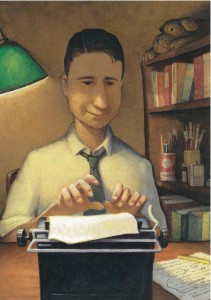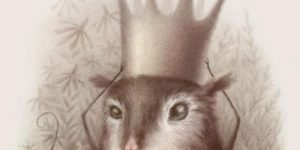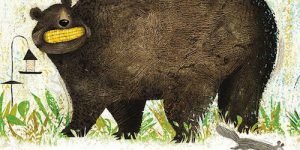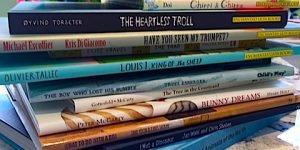It’s sheer coincidence that two back to back posts are picture book biographies of the early lives of famous people. Last week, it was Jane Goodall. This week, it’s Dr Seuss, aka Theodor Geisel. It’s fascinating to look back at a childhood and pluck out the experiences that in hindsight are the set pieces for an extraordinary life. This could be said of any life, famous or otherwise, but with someone like Dr Seuss, whose stories and illustrations are so idiosyncratic, so recognizably Seuss, it’s downright thrilling.
In The Boy On Fairfield Street: How Ted Geisel Grew Up to Become Dr. Seuss, Kathleen Krull does a masterful job of distilling the formative experiences of the great man’s early life. Interestingly, the pictures accompanying the story are not by Seuss but by Steve Johnson and Lou Fancher, the husband and wife super duo responsible for some of the most beautiful picture books of all time (in my opinion), including Peach & Blue, a 32 Pages favourite. It’s a coalition of amazing talent, and even if you don’t know a Who from a Sneetch, The Boy on Fairfield Street is a witty and moving account of growing up odd in a factory-issue world.
Theodor, or ‘Ted’ Seuss Geisel was born in 1904 in Springfield, Massachusetts. He lived at 74 Fairfield Street (not far from Mulberry Street) in a gray, three-story house ‘three blocks from public library and six blocks from the zoo.’ As the only boy in a close-knit family of German immigrants, Ted’s prodigious imagination was stoked by his experiences in and around his middle-class neighbourhood; a catalogue of impressions waiting to be expressed.
In many respects, his childhood was idyllic, especially at home. A brewmaster by trade, Theodor Geisel senior was also the superintendent of parks; he ran the zoo, in other words. Bears, monkeys and lions were the stuff of dinner table conversation. His mother would read stories and nonsense verse to Ted each night as he curled up beside Theophrastus, a stuffed dog that followed Ted throughout his life. Outside the home, things were not quite so idyllic. As WWI and Prohibition descended upon the inhabitants of Springfield and the rest of America, young Ted had to deflect the daily taunts and occasional fisticuffs of the local thuggery who were none too pleased with their Teutonic, beer-slogging neighbours. Not surprisingly, Ted’s adventures were primarily of the mind, not of the body. I’m not sure why a certain level of sports suckitude is so pervasive amongst the doodlers of the world, but suffice to say, his teachers despaired at his lack of musculature, and his parents, award-winning target shooters, tried and failed to get the shy boy involved in competitive sports. It was ever thus; I hear Michelangelo threw balls like a girl.
While his parents encouraged his talents, even helping him to enter a cartoon in the Springfield Union drawing contest (which he won), at school colouring ‘outside the lines’ (and on walls) was not held in high esteem. Full of humour, with a fondness for exaggeration, the one and only art class he took was an exercise in futility: his animals looked like plants, his plants looked like Ruffle-Necked Sala-ma-goox’s. Ted refused to play by the rules, and quit the class after a few days. Geisel’s non-conformist personality followed him to Dartmouth College, where he was editor of the Jack-O-Lantern, Dartmouth’s humour magazine, and later to Oxford University, where he met his wife after she made a favourable remark about his flying cows.
Krull follows Seuss to Greenwich Village in New York as a 22 year old freelance cartoonist and humourist. Throughout the book, she provides just enough detail to flesh out his experiences while keeping the story focused on Seuss’s slightly crooked path to an unconventional career (and life.) These moments are symbolized by a familiar Seuss character or drawing on each page of text, suggesting that as fantastical as his illustrations were, they were nevertheless as biographical as his words.
 The inclusion of these delightful Seussian cartoons does not deter from the gorgeous illustrations by Steve Johnson and Lou Fancher. The watercolour panels perfectly capture the first decades of Theodor Geisel’s life, incorporating humour, a kind of stylized, soft-featured portraiture, and great attention to early 20th century period detail (ie., lots of short pants and vests.) Johnson and Fancher vary the way in which they apply their media from project to project, but to a book, each one exudes charm, beauty, and warmth, especially true of The Boy on Fairfield Street, which surprisingly is not their first Seuss book. My Many Colored Days, written in 1973 but not published until after his death in 1991, is another example of their virtuoso skills as illustrator and designer.
The inclusion of these delightful Seussian cartoons does not deter from the gorgeous illustrations by Steve Johnson and Lou Fancher. The watercolour panels perfectly capture the first decades of Theodor Geisel’s life, incorporating humour, a kind of stylized, soft-featured portraiture, and great attention to early 20th century period detail (ie., lots of short pants and vests.) Johnson and Fancher vary the way in which they apply their media from project to project, but to a book, each one exudes charm, beauty, and warmth, especially true of The Boy on Fairfield Street, which surprisingly is not their first Seuss book. My Many Colored Days, written in 1973 but not published until after his death in 1991, is another example of their virtuoso skills as illustrator and designer.
 Wishing to continue my Seusscation, I pulled Dr Seuss & Mr Geisel, a biography by Judith and Neil Morgan, off my shelf. I’d perused the book years ago, but found myself reading it all over again from beginning to end. While The Boy on Fairfield Street is a perfect, kid-friendly synthesis of Seuss’s young life, Dr Seuss & Mr Geisel is an engaging portrait of one of the most extraordinary and complex personalities of the 20th century. In fact, there is no end to the Seussian oeuvre; one book leads to another, and thankfully, there are many books, including these two incredibly fascinating, beautifully executed biographies. Oh, the places we can go because of Dr Seuss.
Wishing to continue my Seusscation, I pulled Dr Seuss & Mr Geisel, a biography by Judith and Neil Morgan, off my shelf. I’d perused the book years ago, but found myself reading it all over again from beginning to end. While The Boy on Fairfield Street is a perfect, kid-friendly synthesis of Seuss’s young life, Dr Seuss & Mr Geisel is an engaging portrait of one of the most extraordinary and complex personalities of the 20th century. In fact, there is no end to the Seussian oeuvre; one book leads to another, and thankfully, there are many books, including these two incredibly fascinating, beautifully executed biographies. Oh, the places we can go because of Dr Seuss.
The Boy on Fairfield Street: How Ted Geisel Grew Up to Become Dr Seuss by Kathleen Krull, illustrations by Steve Johnson and Lou Fancher. Published by Random House, 2004 Please visit Kathleen Krull’s website for more about his fabulous (and prolific) children’s author.
Dr Seuss & Mr Geisel: A Biography by Judith and Neil Morgan. Published by Random House, 1995
Other Seuss books reviewed in this blog: What Was I Afraid Of?, I Had Trouble in Getting to Solla Sollew











Thanks for bringing this book to my attention! I love Dr. Seuss and am planning a Dr. Seuss Week at my school next year. Must get my hands on this book. The illustrations are outstanding.
An unusual life indeed – it is to our benefit how he turned to his creative mind as his outlet. Another great biography.